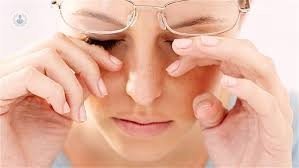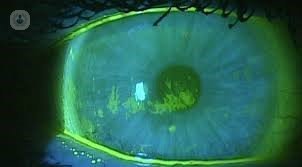Dry Eye: symptoms, diagnosis and treatment
Written by:Dry eye is a chronic condition of the functioning of the tears and ocular surface. The causes can be multiple and is estimated to affect approximately 15% of the world population. Usually it manifests from 45, mostly women, due to decreased tear secretion or because there is an increased evaporation.

Causes of dry eye
There are some causes of dry eye characteristics:- Age- To be a woman- Eye Allergies- Environmental factors- Hormonal changes- Smoking- Alterations of the Meibomian glands (main cause)- Fibromyalgia- Certain systemic diseases, the main rheumatoid arthritis, fibromyalgia and followed by diabetes mellitus- Migraines- Some medications- History of eye surgery (first ophthalmologic cause)- Use of contact lenses
Besides these has also been shown that prolonged reading, by the reduction of flicker is related, it may be another of the causes that produce dry eye. By increasing the time between flashes causes the tear is not distributed well and evaporation increases. This is increased in patients using reading glasses because the flicker is further reduced.
How dry eye symptoms courses
In groups of patients at risk of developing dry eye it is important to conduct a thorough assessment by the specialist in ophthalmology , to give you tips on how to relieve symptoms of dry eye and how to plan treatment.
Dry eye alters and causes instability of the tear film, which, in turn, leads to discomfort and visual disturbances. In general, patients with dry eye have the following symptoms:- Foreign body sensation- irritation- Blur- Light Photosensitivity- Red eyes- Eye Itch- Tearing
There are also certain environments in which greater sense of symptoms, especially those with pollution, smoke or wind shown. Atmospheric or seasonal variations can also increase symptoms, and even air conditioners and heating produce more feeling of eye dryness. In patients with dry eye it is recommended not to keep the room closed when the heating is turned on, by itself it gives off heat, which helps the tears evaporate, increasing the feeling of dryness.
In any case of dry eye should avoid rubbing the eyes, because they can cause small lesions in the cornea.

How to diagnose dry eye
To diagnose dry eye must carry an assessment optometric eye-full. In this sense, the ophthalmologist will analyze the quality and quantity of tear film, displayed the cornea with a slit lamp and evaluate the conjunctiva, eyelids and meibomian glands. This will assess whether the quantity or quality of tear has been reduced or has been injury to the cornea and / or conjunctiva.

Avenues of treatment for dry eye
Although various treatments have been developed to reduce the symptoms of dry eye to make daily life bearable patient to date it has not been achieved fully heal.
The main treatment for dry eye include artificial tears or eye lubricants. Specifically tears containing hyaluronic acid have been proven very effective in reducing symptoms. Moreover, within the possibilities of administration of tears, gels have a more durable and comfortable effect. Regarding the manner of use of artificial tears, it is important to get in the correct position to avoid spillage and not take effect. Once inside the eye, it is important to blink several times to redistribute.

Importantly, not all tears are equal and that each patient needs those suitable to your situation.
When artificial tears fail to reduce symptoms will be used to other treatments, such as obstruction of puncta to preserve the tear, PRP serum or anti - inflammatory agents, among others.
It is also very important to massage the Meibomian glands and clean them carefully.
We have also developed systems based on thermal pulse treatment, although the results are inconclusive. When all this is not enough because dry eye is more advanced they have been proven effective by its larger diameter scleral contact lenses. These lenses allow to keep the tear and slow evaporation.
Moreover, the ophthalmologist will recommend cessation treatments that can increase symptoms and reduce exposure to some natural environments that also make them increase.


